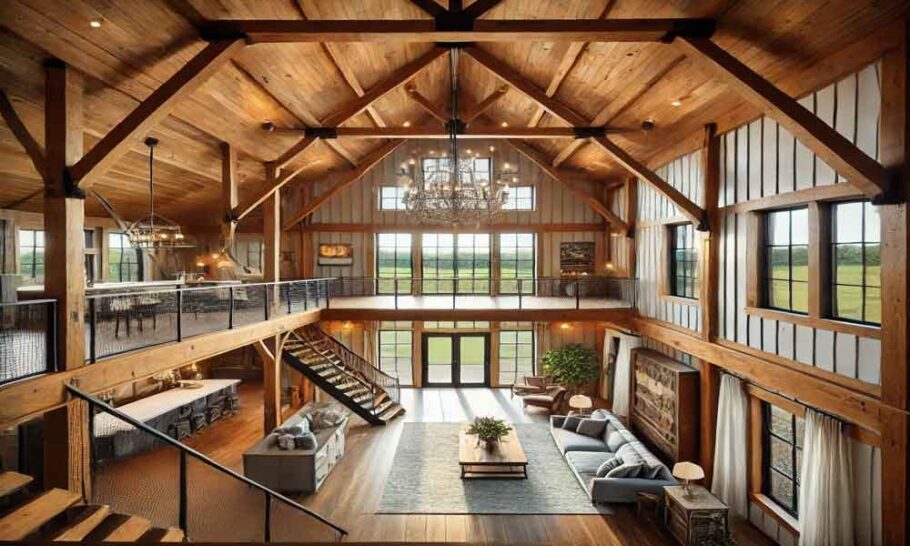Barndominiums—those stylish hybrids of barn-style architecture and modern living—are prized for their open floor plans, soaring ceilings, and flexibility. Yet, even with all that space, poor planning can make them feel cluttered or inefficient. Whether you’re designing a 1,200-square-foot barndo or a sprawling 4,000-square-foot one, the key to comfort and functionality lies in how you use every inch.
This guide explores proven strategies for maximizing space in a barndominium—through design, layout, storage, and multi-purpose planning—so you can live large, even in a compact footprint.
1. Start with an Intentional Floor Plan
The most effective way to maximize space begins long before construction starts—during the design phase.
- Define your zones early
Instead of treating the barndominium’s open layout as a blank slate, think in terms of zones: sleeping, cooking, dining, relaxing, and working. By visualizing how you’ll use each area, you can size them realistically. Oversizing one zone (like the kitchen) often means undersizing another (like the laundry). - Minimize hallways and dead zones
Traditional homes often lose valuable square footage to hallways. In a barndo, you can eliminate most of that by using open-concept transitions—like having the kitchen flow directly into the living area or bedrooms accessed via a shared central space. - Consider flow and function
Think about how you move through the house daily. For example, placing the laundry near the primary bedroom or garage entrance saves steps and makes chores easier. Every functional adjacency reduces wasted time and space.
2. Use Vertical Volume Wisely
One of the most iconic features of barndominiums is their high ceilings. But a tall space can feel underutilized unless you design intentionally.
- Add lofts for bonus space
Lofts are one of the best ways to reclaim “dead air.” Whether used for storage, an office, or a guest room, a loft leverages your vertical square footage without expanding your footprint. - Install mezzanines or partial upper levels
If your barndo has a great room with a vaulted ceiling, consider adding a mezzanine overlooking it. It provides usable space without making the room below feel cramped. - Use tall shelving and built-ins
Instead of standard 7-foot bookshelves or cabinets, go all the way up. Custom cabinetry that reaches the ceiling maximizes storage while creating a visually seamless look.
3. Think Multi-Functional in Every Room
In smaller barndominiums especially, every room should do double duty.
- Combine uses creatively
- Guest room + office: Use a murphy bed or daybed so the space can transform easily.
- Laundry + mudroom: Merge two utility spaces near the back or side entry.
- Dining area + workspace: A built-in banquette with drawers underneath can serve both meals and meetings.
- Choose convertible furniture
Sofa beds, folding desks, and nesting tables make it easier to adapt rooms based on need. - Integrate hidden storage
Benches with lift-up tops, platform beds with drawers, and ottomans with interior compartments reduce clutter without sacrificing aesthetics.
4. Build Storage Into the Architecture
The biggest space-killer in any home is clutter. To keep your barndominium open and breathable, storage must be designed into the structure itself—not tacked on afterward.
- Under-stair storage
If you have stairs to a loft or second floor, the area underneath can house built-in cabinets, a compact office nook, or even a mini wine cellar. - Overhead garage or workshop storage
Many barndominiums include attached shops or garages. Install overhead racks or mezzanine platforms for seasonal items, freeing your main living area. - Built-in closets and pantries
Instead of relying on bulky freestanding wardrobes, integrate closets with sliding or pocket doors. Use adjustable shelving systems to maximize every inch.
5. Optimize Furniture Layout and Scale
The open expanse of a barndo can tempt owners to buy oversized furniture—but that’s a quick path to feeling cramped.
- Choose the right scale
Furniture should fit the proportions of the room. In a smaller barndominium, opt for slim-profile sofas and chairs on legs to maintain visual lightness. - Float furniture, don’t wall-hug
In large open spaces, pulling furniture slightly away from walls can create defined zones and better flow. Rugs, pendant lighting, and partial partitions can help delineate these areas. - Keep pathways clear
A comfortable walkway should be at least 36 inches wide between furniture pieces. Anything tighter feels crowded and interrupts flow.
6. Use Light and Color to Expand Perception
Sometimes, maximizing space isn’t about adding square footage—but making what you have feel larger.
- Choose light, cohesive colors
Whites, soft grays, and pale woods reflect more light, making rooms feel airy. Too many contrasting tones break up visual continuity. - Maximize natural light
Install large windows, transoms, and skylights. In metal barndos, consider adding clear panels to upper walls to brighten interiors. - Use mirrors strategically
Mirrors placed opposite windows double perceived depth and bounce light around the room.
7. Design for Storage Efficiency in the Kitchen and Bathrooms
These are often the most space-demanding areas in any home—and smart planning here pays off hugely.
- Vertical pantry pull-outs
Tall, narrow pantry cabinets provide deep storage without occupying large footprints. - Toe-kick drawers
That 4-inch space beneath base cabinets can hide slim drawers for baking sheets or cutting boards. - Over-toilet shelving and recessed cabinets
Bathrooms benefit from built-in niches in showers or walls—perfect for storing toiletries without bulky shelving. - Sliding or pocket doors
Wherever possible, use sliding or pocket doors instead of swinging ones to save 10–12 square feet per door.
8. Combine Outdoor and Indoor Living
In a barndominium, extending usable space to the outdoors can double your living area without increasing the footprint.
- Covered porches and patios
A deep overhang or wraparound porch becomes an outdoor dining or lounge area that’s usable year-round. - Sliding glass or roll-up doors
Connect your main living space with the outdoors seamlessly. Large doors create visual expansion and improve airflow. - Outdoor kitchens and utility zones
Moving cooking or laundry functions outside (in suitable climates) frees interior space and reduces heat buildup.
9. Use Smart Storage in the Workshop or Garage
For many barndominium owners, the attached shop or garage is both a necessity and a potential clutter zone.
- Install wall-mounted systems
Pegboards, slat walls, and modular racks keep tools and supplies accessible without consuming floor space. - Use mobile workbenches
Rolling benches or tool carts allow flexibility and free up room for vehicles or larger projects. - Zone your garage layout
Dedicate one wall for tools, another for storage, and leave a clear path to the living area. This prevents the workshop from becoming overflow storage for household items.
10. Avoid Overbuilding—Plan for Function, Not Excess
It’s easy to assume that bigger is better when it comes to a barndominium. But a larger footprint doesn’t automatically mean better living.
- Right-size your spaces
Instead of a massive great room, focus on a proportionate area that’s comfortable and easy to furnish. - Design for flexibility, not redundancy
You don’t need three separate sitting areas if one well-designed space can serve multiple purposes. - Future-proof your design
Think about how your needs might evolve. Could a home office become a nursery later? Could a workshop bay convert to a guest suite?
11. Incorporate Hidden and Foldable Design Elements
Modern barndominium interiors can include clever architectural solutions that disappear when not in use.
- Fold-down tables and counters
Perfect for small kitchens or hobby spaces—these can be stowed away when you need room to move. - Sliding wall panels
Instead of permanent partitions, movable walls let you open or close spaces as needed. - Drop zones and cubbies
Built-in nooks near entries keep daily essentials organized, preventing clutter from spreading through the home.
12. Work with Professionals Who Understand Efficiency
A barndominium is not a conventional home—it has different load paths, materials, and opportunities for customization. Collaborate with designers who specialize in barndominiums and understand how to integrate living and utility spaces efficiently.
Professionals can help:
- Optimize framing layouts to reduce wasted space between structural members.
- Integrate ductwork and utilities into chase spaces instead of eating into living areas.
- Recommend energy-efficient systems that save both space and costs.
Conclusion: Living Large in a Smartly Designed Space
Maximizing space in a barndominium isn’t about cramming in more—it’s about making each element work harder. When every corner is purposeful, every ceiling height is used, and every piece of furniture pulls double duty, you achieve what barndominium living is all about: freedom, efficiency, and style.
Whether you’re building new or renovating an existing structure, approach every design choice with one question in mind: Does this make the space more livable?
If the answer is yes, you’re well on your way to creating a barndominium that feels spacious, functional, and uniquely your own—no matter its size.

